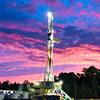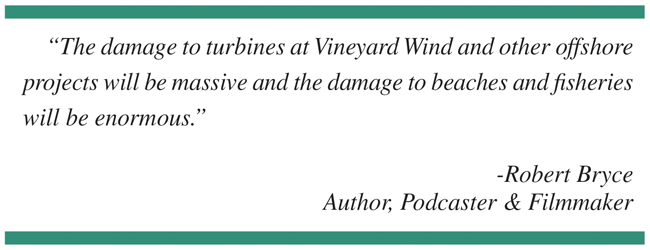
Offshore Wind Faces Turbine Trouble
AUSTIN, TX.—Claims that offshore wind generation is a risk-free, unfailingly benign power source took a hit in July when a wind turbine off the Nantucket, Ma., coast broke and closed many of the famous vacation spot’s beaches. Author, podcaster and filmmaker Robert Bryce recounted the events and placed them in a broader context with a late July Substack article titled “Breaking Wind.”
Bryce’s article cites reports in the Nantucket Current that show the incident has its genesis in a damaged wind turbine in the $4 billion Vineyard Wind project in Massachusetts waters near Nantucket and Martha’s Vinyard. The turbine blade began deteriorating on the evening of July 13, the Current says, but project owners did not notify Nantucket officials for 48 hours.
The next day, the U.S. Department of Interior’s Bureau of Safety and Environmental Enforcement ordered developers to halt work on the project. Then on July 18, amid the cleanup efforts to retrieve the 17 cubic yards of debris that already littered the area’s waters and beaches, the remaining 300-foot portion of the blade fell into the ocean.
“The Coast Guard warned mariners in the area of the wind project, which is located 15 miles south of Nantucket and Martha’s Vineyard, to ‘use extreme caution’ when passing through the region,” Bryce notes. His article then goes on to make the case for why similar caution is in order for further expanding offshore wind projects.
Supersized Challenges
According to Bryce, when it is complete, Vineyard Wind will entail 62 offshore wind platforms that can generate a cumulative capacity of 800 megawatts, and a few turbines already are installed and have been producing power since the beginning of the year.
However, he notes, in the aftermath of the broken turbine, the Nantucket Select Board is weighing litigation against Avangrid and Copenhagen Infrastructure Partners, which own Vineyard Wind. Bryce’s article also highlights the extent to which Vineyard Wind sits amid North Atlantic Right Whale habitat, which is prompting some local activists to oppose the project.
Many of the project’s technical headaches are a natural consequence of modern turbine design, Bryce emphasizes. “The turbines now being deployed onshore and offshore are failing far sooner than expected,” he relates. “Why? They have gotten too big. Yes, bigger wind turbines are more efficient than their smaller cousins. But the larger the turbine, the more its components get hit by the stresses that come with their size and weight. The GE Vernova Haliade-X wind turbine used at Vineyard Wind stands 260 meters high and sweeps an area of 38,000 square meters. That means the turbine captures wind energy over an area five times larger than a soccer pitch.”
The components of that apparatus entail a great deal of mass, he observes. “Its blades are 107 meters (351 feet) long and weigh 70 tons,” Bryce observes. “In addition, the rotor of the massive machine spans 220 meters. For comparison, the wingspan of a Boeing 737 is 34 meters. In other words, the turbines at Vineyard Wind are nearly as tall as the Eiffel Tower and each of their blades weighs more than a fully loaded 737.”
And that same Haliade-X rotor equals the collective wingspans of more than six 737s, he calculates. “Given the enormity of the machines, it’s no wonder they are failing,” Bryce suggests.
The article goes on to cite media reports about other wind turbine malfunctions in a trio of Oklahoma wind projects, and notes that earlier this summer American Electric Power sued GE Vernova because of turbine flaws. Quoting published reports on the matter, Bryce notes that the plaintiffs claim that in only a few years of commercial operation, the turbines’ major components have begun to demonstrate numerous material defects or have stopped operating completely.
The press accounts show that AEP says the failures have cost it millions of dollars, while GE Vernova refuses to accept responsibility to address the defective generators. They also show that AEP’s claim for cash damages also is accompanied by a quest for a declaratory judgment that GE Vernova will be liable for any of the wind turbines’ future failures.
“How much is at stake in the AEP v. GE Vernova litigation?” Bryce poses. “According to one report, the turbines in question have a capacity of 1.5 gigawatts and cost $6.4 billion. Thus, it’s easy to imagine that GE Vernova could be on the hook for hundreds of millions of dollars in losses. Furthermore, those losses may be only part of the company’s long-term liabilities.”
Bryce notes that GE Vernova is by no means the only wind turbine manufacturer facing such problems. “Germany’s Siemens Energy also has announced it would take a $2.4 billion loss on its wind business due to quality problems with its wind turbines,” he points out. “And remember, these failures and losses are happening with onshore wind turbines. The looming operation and maintenance costs for offshore wind will be astronomical.”
A Bad Bet
Predictions that such massive wind turbines may not be suitable for offshore environments have by no means been limited to skeptics of alternative energy, Bryce notes.
“Among the most disgusting aspects of the offshore wind scam—including the fact that foreign companies are collecting billions of dollars in tax credits so they can industrialize our oceans and do harm to our fisheries, and the critically endangered North Atlantic Right Whale—is that the current disaster was easily foreseen,” he assesses, noting that in March 2023 at the CERAWeek energy conference, NextEra Energy Chief Executive Officer John Ketchum called offshore wind “a bad bet.”
“NextEra has been hyper-aggressive in its push to site solar and wind projects in rural communities across the country and Canada,” Bryce describes. “NextEra is the world’s largest producer of alt-energy, which means Ketchum knows the industry. Ketchum said of offshore wind, ‘We find it hard enough just to take care of a fleet on shore with some of the issues that we deal with as a company, and we are best in class.”
Bryce then cites a Reuters article that recounts the offshore challenges Ketchum mentions, including saltwater corrosion, the threat of hurricanes, vessel availability, the installation of subsea transmission cables and supply chain issues.
“The crucial part of Ketchum’s statement, is, of course, ‘the threat of hurricanes,’” Bryce muses. “If GE’s wind turbine blades are coming apart now, during a calm summer day, imagine the calamity when a large hurricane slams the Eastern Seaboard. The damage to turbines at Vineyard Wind and other offshore projects will be massive and the damage to beaches and fisheries will be enormous.”
Bryce’s article also features Nantucket fisherman and former select board member Bob DeCosta, who insists that offshore wind projects’ are exacting an environmental cost that appears likely to grow with time: “DeCosta is staggered by the size of the wind turbines and furious at how Nantucket’s residents and fishermen have been ignored. ‘There are other ways to produce energy without doing this to our oceans,’ he said. ‘I know a thing or two about the saltwater environment. I can’t imagine what it will take to keep these things running in salt water.’”
And what does DeCosta think a hurricane will do to an offshore wind installation? “We will be picking up the pieces from this on the beaches at Nantucket for the next 20 years,” Bryce quotes him. “When this stuff is obsolete, who’s going to pay to remove it? They are talking about a total of 1,400 of these things.”
But he is not giving up, Bryce adds. “DeCosta told me the turbine blade failure at Vineyard Wind is, in a way, good for opponents like him. ‘My hope is that we make enough of a stink that they don’t put up any more of these things. We aren’t giving up,’” he concludes.
For other great articles about exploration, drilling, completions and production, subscribe to The American Oil & Gas Reporter and bookmark www.aogr.com.















